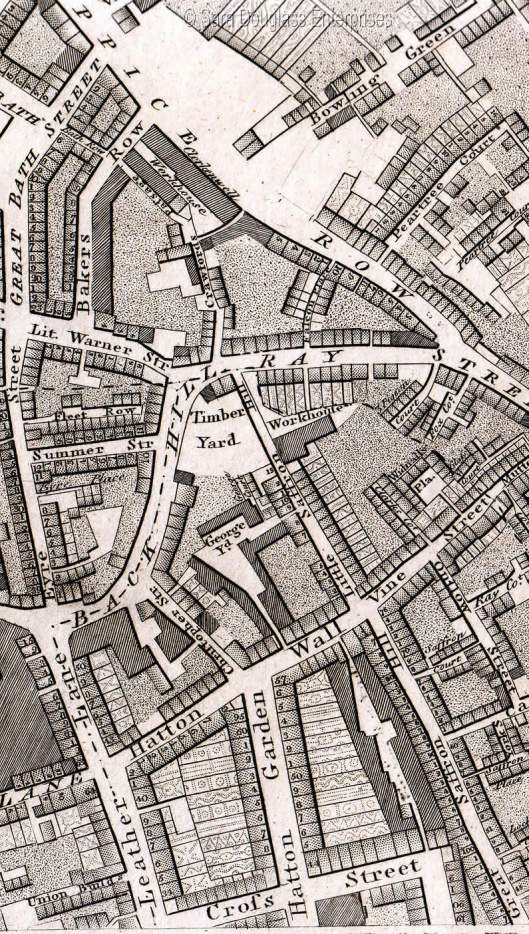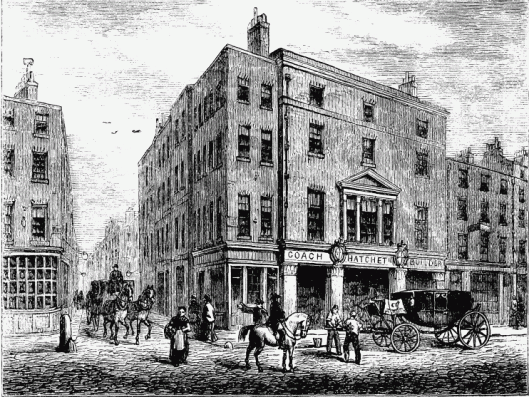The third Blanch sibling to marry was Thomas, who had been born in Holborn in 1797, the second child of my 4 x great grandfather James Blanch and his second wife Sophia Atkins. Thomas had been christened on Boxing Day, and he was married on Christmas Day. On 25th December 1820, when he was twenty-three years old, Thomas Blanch married Ann Akerman Fletcher at St Anne’s, Soho, the church where his parents had married twenty-eight years earlier. Ann, who was sixteen at the time of her marriage to Thomas, had been born in the parish of St Clement Danes, Westminster, in 1804. She was the daughter of George Fletcher and Ann Akerman – the latter hailing from Bristol, suggesting that there may have been a connection with the Blanch family.
The Christmas wedding was a double one. One of the witnesses to the marriage of Thomas Blanch and Ann Fletcher was George Fletcher, Ann’s brother. On the same day, in the same church, George married Ann Wing: one of the witnesses was Thomas Blanch. George Fletcher junior worked as a surveyor, and he and his wife Ann would live in the same street as Thomas and Ann Blanch: Mutton Hill, also known as Vine Street, which ran between Saffron Hill and Clerkenwell Green. They would also give their firstborn son, Charles, the middle name Blanch.

Part of Horwood’s 1792 map of London, showing Saffron Hill, Vine Street / Mutton Hill, and Widnall Place (via motto.com)
Thomas and Ann Blanch’s first child, Thomas George, was born at Mutton Hill on 18th November 1821 and christened at St Andrew’s, Holborn, on 7th April in the following year. The parish register describes Thomas senior’s occupation as ‘coachsmith’. We know that Thomas and his brother David would be in the coachbuilding business together, and that their brother William Henry also worked with them. However, in 1822 William and David were aged eighteen and twelve respectively, so Thomas probably started out in business on his own.
How the sons of James Blanch, a patten maker, came to be coachsmiths is a mystery. The only previous family connection with coachbuilding that I can find is the fact that James’ brother-in-law Henry Davis, the husband of Hannah, sister of his first wife Jane Barlow, was a coach maker in Tottenham Court Road.

Coachbuilder’s shop in Long Acre, Covent Garden (via www.british-history.ac.uk)
Thomas and Ann Blanch’s son Thomas George died in infancy and was buried at St James’ church, Clerkenwell, on 14th September 1823. On 15th May of that year, their second child, Mary Ann Sophia, was born. She was christened at St Andrew’s, Holborn, on 2nd June. By this time, the Blanch family were living in Widnalls Place, just off Mutton Hill. A third child, William Henry, was born at the same address on 20th January 1825 and baptised at St Andrew’s on 20th February.
I’ve been unable to find any trace of Thomas and Ann Blanch in the 1841 census records. However, there’s a strong probability that they were living in Soho, in the parish of St James, Westminster, for which some census records from this date are missing. It was here that their daughter Mary Ann would be married, and also where their son William Henry’s wife was born. Moreover, Thomas’ brothers David and William both lived in the area by this time, and their coach-making business was based there, in Ham Yard, off Great Windmill Street.

Ham Yard from Great Windmill Street in 2008 (author’s photograph)
The London Directory includes entries in 1835, 1838 and 1840 for ‘Blanch, Thos & David Coachsmiths Ham Yd, Gt Windmill St.’ The partnership between the brothers lasted until July 1846 when an advertisement placed in the London Gazette declared:
We hereby agree to dissolve the partnership now existing between us in the business as Coach Smiths, now and for some years past carried on by us in Ham-Yard, Great Windmill-Street, Saint James’s, Westminster from and after Saturday next the 18th instant.
David Blanch
Thomas Blanch
In 1843 Thomas and Ann Blanch’s daughter Mary Ann Sophia married market gardener Thomas Bagley at the parish church of St James in Piccadilly. Born in the Fulham Road in 1822, Thomas was the son of another market gardener, William Bagley, and his wife Ann.
Thomas and Ann’s son William Henry married Emma Ann Wilson, the daughter of Joseph Wilson, a farrier, and his wife Emma, at St Martin-in-the-Fields on 23rd November 1847. In 1851 William Henry could be found sharing a house in South Parade, Fulham, with a police constable’s family, and working (presumably with his father) as a coach smith. It’s possible that Emma was only temporarily absent on the day of the census, and that the house in South Parade was their marital home, though later records hint at a separation of some kind.
William’s parents Thomas and Ann Blanch had also moved to Fulham by this date, sharing a house with their daughter Mary Ann Bagley and her family in North Row. By this date Thomas and Mary Bagley had three children: Thomas, six; (Marian) Louisa, three; and William Henry, one. Also living with them was Ann Blanch’s widowed mother, Ann Fletcher, now aged sixty-seven.

Fulham in the 1860s: still a semi-rural suburb of open fields and market gardens (from Stanford’s Library Map of London and Its Suburbs: via london1864.com)
Thomas Blanch died in the last quarter of 1858:he was sixty-one years old. In 1861 his widow Ann was living with the Bagleys at 18 Grove Road, Fulham Fields. Thomas Bagley was still working as a market gardener, while the eldest Bagley child, Thomas junior, sixteen, was employed as a farrier. There were now two additional Bagley children: Helena Ann, five, and Emily Sarah, two. Thomas Bagley senior died in 1866 at the age of forty-four. In 1871 his widow Mary Ann, forty-seven, can be found working as a needlewoman and living at 12 St Thomas Road, Fulham, with her widowed mother Ann Blanch, sixty-seven, and her daughter Louise, twenty-three, who was working as a domestic servant. Curiously, daughter Emily Sarah, age eleven, seems to have been boarding at an Industrial School in Wimbledon: these schools were for poor and neglected children, as well as those found guilty of juvenile delinquency.
Ann Blanch née Fletcher, Thomas Blanch’s widow, died in 1882 at the age of seventy-seven. Her daughter Mary Ann Sophia Bagley née Blanch died in 1888 at the age of sixty-four. I’m not sure what became of Thomas Bagley junior or Helena Ann Bagley. William Henry Bagley seems to have followed in his father’s footsteps, working as a market gardener.

Old photograph of Shakespeare Head pub, Wych Street (via pubshistory.com)
What became of Thomas and Ann Blanch’s son William Henry after 1851 is something of a mystery. I’ve found no further records for him, and no evidence of any children born to him and his wife Emma. I’ve been unable to trace either William or Emma in the 1861 census. However, in 1871 we find Emma Blanch, now aged forty-four, living at the Shakespeare Head in Wych Street, between the Strand and Drury Lane, and working as a sempstress. Apparently this pub was patronised by Charles Dickens and other literary luminaries of Victorian London. At this time Emma was still described as a ‘wife’, despite the absence of her husband, but by 1881, when she was still at the same address and working as a laundress, she was said to be a widow, so William must have died in the interim. Both census records note that Emma Blanch was deaf.

I found two axles with partial wheels, local to me. I managed to find on the end of one of the axles was stamped “T. BLANCH BUILDER CHELSEA”. Thought id research about it and came across your article which was a great help. I would assume that it was built by one of the descendants of David Blanch, either his son Thomas or his grandson. Thank you for your article.
LikeLike